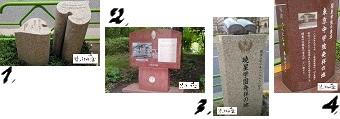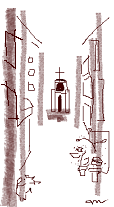 Hello, this is Minato kid.
Hello, this is Minato kid.
Today, I would like to walk along the green path in front of St. Luke Garden.
The planting in the sidewalk is lush, small waterways run, and cherry blossom trees are beautiful in spring.
Let's visit the precious remain and monuments that tell you that there was Tsukiji foreign settlement in Meiji period here in Akashicho.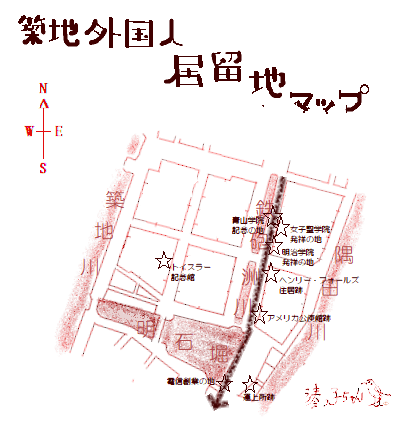
♪ Toysler Memorial Hall
In 1933 (1875), a missionary hall of St. Luke International Hospital was built on the banks of the Sumida River. J. Bergamini was also involved in the design of St. Luke's International Hospital. It is a two-story building made of reinforced concrete, partially wooden, and is a solid stately building reminiscent of a European mountain villa.
The exterior has a half-timber-style design that expresses pillars and beams, and the interior has a tuder-Gothic style, the entrance and living room, etc., with a solid wood interior. It was relocated and restored in 1998 and is now located in the courtyard of St. Luke's International Hospital.
 ♪ U.S.
♪ U.S.
In 1859 (1859), Harris, the first American minister, opened the American ministerial office in Zenpukuji, Minato-ku. Then, the following year, a new envoy was built on the Tsukiji foreign settlement, and the shape was adjusted here. It is said that it was a wooden two-story, cream-colored Western-style building.
In 1890 (1890), I moved to Akasaka, the current location of the American Embassy. On the site of the Tsukiji foreign settlement, there were five monuments made of Komatsu stone. A pattern symbolizing the United States is engraved on a stone about 1m square.
Two monuments are preserved in the courtyard of St. Luke's Garden, three in front of St. Luke's International Hospital courtyard and in front of the Toysler Memorial Hall.
 ♪ The ruins of Henry Falls residence
♪ The ruins of Henry Falls residence
Henry Falls, a missionary physician of the Scotland Conforming Elders, lived here during his stay in Japan from 1874 (1874) to 19 (1886).
I was interested in the practice of fingerprinting in Japan and conducted scientific fingerprint research. In 1880 (1880), a paper submitted to the British magazine Neurea is said to be the world's first paper on scientific fingerprinting, in which he presented his personal identification experience of criminals and referred to the genetic relationship of fingerprints. Later, in 1911 (1911), the Japanese police adopted the fingerprint method for the first time.
♪ Monument on the banks of the Sumida River

1.Monument at the site of the Tsukiji Unjosho
In 1867 (1867), the Edo Shogunate designated the whole area of Akashicho, Tsukiji Gunsho, as a permanent residence for foreigners in Tsukiji, and established a luck office for customs duties. This is the beginning of Tokyo Customs.
2.Local monument founded by telegraph
In 1869 (1869), the construction of a telegraph line of about 32 km was started connecting the Yokohama Court and the transmission station office located in Tsukiji Unjo, Tokyo. Started operations in December of the same year. It was Japan's first public telecommunications and played a major role in Civilization and enlightenment.
♪ School monument
1.Aoyama Gakuin Memorial Monument 1877 (1877)
2.Monument of the birthplace of Meiji Gakuin, 1877 (1877)
3.Monument of Birthplace of Women's Seigakuin 1905 (1905)
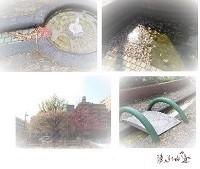 In spring, Minatoko likes the appearance of cherry blossom petals floating on the sparkling water surface.
In spring, Minatoko likes the appearance of cherry blossom petals floating on the sparkling water surface.
There is a small fountain in the waterway, and there is a pretty bridge that stretches in just a step.
This is an unnamed road, but it is a unique street that delights the walkers.
Correspondent Minato kid, Chuo-ku Tourism Association

No. 29 December 9, 2018
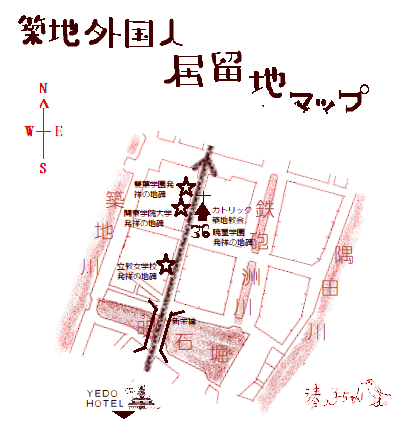
 The design and construction was considered to be Kisuke Shimizu, and it was a large hotel with a wooden two-story building and 102 guest rooms.
The design and construction was considered to be Kisuke Shimizu, and it was a large hotel with a wooden two-story building and 102 guest rooms. ♪ The entrance to Tsukiji Foreign Settlement
♪ The entrance to Tsukiji Foreign Settlement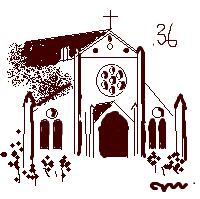 In 1878 (1878), a Gothic-style red brick cathedral was built. In 1888 (1888), Xiaosei Gakuen originated in the sacred school. However, it was burned down by the Great Kanto Earthquake. The current cathedral was rebuilt in 1927 (1927) under Father Gyrodias.
In 1878 (1878), a Gothic-style red brick cathedral was built. In 1888 (1888), Xiaosei Gakuen originated in the sacred school. However, it was burned down by the Great Kanto Earthquake. The current cathedral was rebuilt in 1927 (1927) under Father Gyrodias. What is preserved in the cathedral is the Angelas bell, nicknamed "Janne Louise of Edo". It was given by Renne, France in 1876 (1876), and was a pair of two large and small bells. Louise is the smaller one. The large Josephine moved to Sekiguchi Church with the Archbishop in 1920 (1920).
What is preserved in the cathedral is the Angelas bell, nicknamed "Janne Louise of Edo". It was given by Renne, France in 1876 (1876), and was a pair of two large and small bells. Louise is the smaller one. The large Josephine moved to Sekiguchi Church with the Archbishop in 1920 (1920).